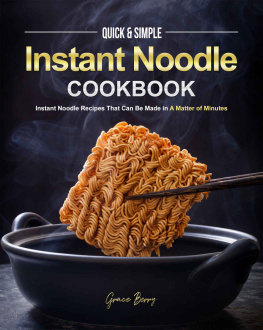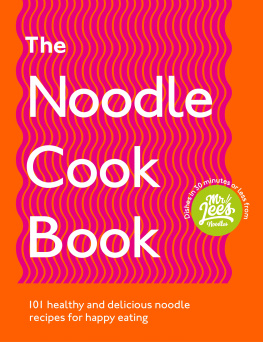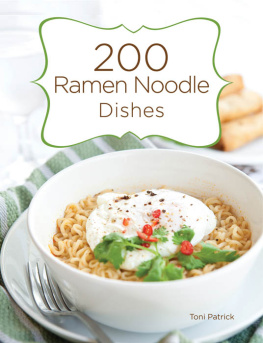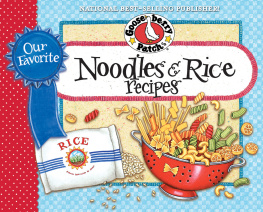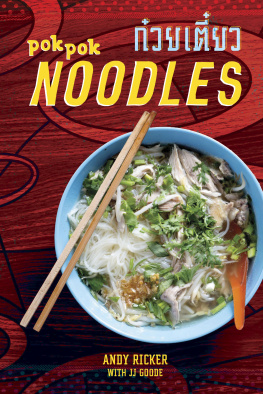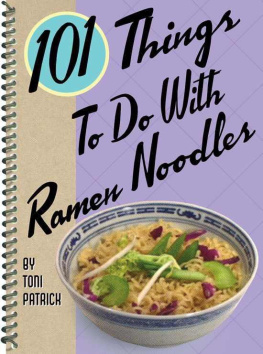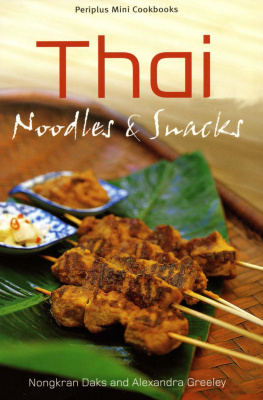CONTENTS

Copyright 2014 by Brian Yarvin
All rights reserved. No part of this book may be reproduced in any form or by any electronic or mechanical means including information storage and retrieval systems without permission in writing from the publisher, except by a reviewer, who may quote brief passages.
Interior photographs by the author unless otherwise specified
Book design and composition by Karen Schober Design
Published by The Countryman Press, P.O. Box 748, Woodstock, VT 05091
Distributed by W. W. Norton & Company, Inc., 500 Fifth Avenue, New York, NY 10110
The Library of Congress has cataloged the printed edition as follows:
A World of Noodles
ISBN 978-1-58157-210-0
ISBN 978-1-58157-686-3 (e-book)


Most of the ingredients called for in this book are pretty easy to find. Some are in supermarkets, and many others are in ethnic groceries or bulk food shops. The more unusual ones might take a bit more effort to locate. This list includes some tips on where to look, and what to look for.
Achiote pasteAlso called annatto. Looks like brick-red clay. Find it in Latin American grocery stores.
Anchovy filletsEven though they cost a bit more, try to find the ones packed in olive oil and sold in glass jars.
AsafoetidaAlso known as hing; make sure you buy the powdered form in a resealable packageits strong stuff.
Beef brothIf youre not making it yourself, try a few different brands to see which one you like best. Many people swear by the boxed varieties, although Ive had pastes I like too. Save the dry cubes for camping trips.
Beef jerkyThe American term for strips of dried beef. Make sure that the jerky you use has no other seasoning than the salt thats required to dry it.
Belacan Malaysian fermented shrimp paste. Larger Asian markets usually stock it in the Malaysian section; otherwise, look for it among other pastes and concentrates.
Belgian-style aleMany American microbreweries offer a version of this. Dont forget to buy some to drink alongside your meal too.
Berbere spice mixtureAn Ethiopian specialty, it can be found at Ethiopian grocery markets and specialty spice shops.
Black cumin seedsAlso called nigella seeds, but easiest to find as kalonji, or onion seeds; find them at Indian grocery stores.
Bonito flakes, driedThe shaved fish of Yoko Ono fame. Find them in the Japanese section of Asian grocery stores and supermarkets or at Japanese specialty stores.
Borlotti beansAn Italian specialty. If you cant find them, substitute the very similar cranberry bean.
Bottarga (dried mullet roe)Again, an Italian specialty; called Italian caviar by some. Like Parmesan, its sold as either solid blocks you grate yourself or pregrated. Can be ordered online.
CapersIt doesnt matter if you buy salted or brined. Theyre used the same way.
ChayoteThis is technically a fruit but its eaten like a vegetable; it looks a bit like a green pear. Both Latin and Asian markets will have it.
Chicken brothAs with beef, if youre not making it yourself, try a few different brands to see which one you like best. Many people prefer the boxes over the cans, although Ive had pastes I like too. Best to save the dry cubes for camping trips.
Chile oilSupermarkets with good Asian sections sometimes carry it; otherwise, youll need to visit a Chinese grocery.
Chinese broccoliA green stalked vegetable (kai-lan in Cantonese) that somehow acquired this name here in the States. Its sold as Chinese broccoli even in shops that cater mainly to Asian consumers.
Chinese chivesMore garlicky than regular chives. However, you can substitute regular chives in a pinch.
Chinese pickled cabbageThis is sold in small cans at most Chinese markets. If you have any left over, store it in a plastic container.
Chinese sausageSmall, thin dry sausages with a texture similar to Mexican chorizo. Try to get them from a Chinese butcher if possible. Otherwise, the packaged ones will do.
Chipotle peppersThese are smoked chiles that are sold canned in a spicy sauce. You can get them in the Mexican section of most supermarkets.
ChorizoFind this salami-like sausage in any Mexican or Latin American market.
Choy sumAlso referred to as choy sum cabbage. Similar to Chinese broccoli. Look for it in Asian grocery stores.
Coconut, shreddedTry to find the frozen product sold at Indian and Asian grocery shops. Otherwise, dried will do. Note that the recipes in the book always call for unsweetened coconut. Of course, if you live in a place with fresh coconuts, use fresh.
Coconut milkCanned coconut milk is easy to find, but frozenwhich you can buy in some Asian shopstastes far better.
Curry leavesNothing at all to do with curries, curry powder, or curry paste. Instead, theyre intensely flavorful leaves found in the produce section of Indian grocery stores. Look for dried curry leaves if you cant find fresh.
Curry pasteThese days, you can find it in the Indian section of many supermarkets or on the shelves of Indian grocery stores. If you cant find it, use an equal amount of curry powder + a teaspoon of peanut oil instead.
DaikonLarge white radish that looks more like a huge, fat carrot. Surprisingly common once you know what to look for.
Dashi brothA classic Japanese item. Find it as either a powder or liquid. Use the liquid if you can.
Deep-fried onionsSold in large plastic bags or cans in Indian grocery stores. Use them sparingly; theyre high in calories and impossible to stop eating from the bag once you start.
Dried shrimpA staple in many Asian cuisines, these are easily found in Chinese supermarkets. Even though theyre dried and relatively stable, I prefer to store them in a tightly sealed package in the fridge.
Dried shrimp pasteA paste made from dried shrimp. Its sold in small jars and found in Asian supermarkets.
Dry unseasoned breadcrumbsYou can find these in the supermarket. Read labels carefully to make sure theres no added salt or seasoning.
Durum semolina flourSupermarkets with good baking sections will have it. Make sure its both durum and semolina (see ).
Fish sauceA salty liquid condiment used all over Southeast Asia. Its the color of a good lager beer and has a unique taste and fragrance youll either love or hate.
Galangal rootSubstitute frozen galangalwhich many Asian grocery stores carrywhen you cant find fresh.
Garam masala powderEasily found in Indian grocery stores, and often stocked in the international section of supermarkets. Dont use whole garam masala instead!
Ginger garlic pasteSold in glass jars. Easily found in Indian grocery stores.
GuancialeItalian cured pork cheek. Substitute pancetta or even bacon if you cant find it.
HarissaNorth African chile paste. Try to buy it in a reclosable glass jar instead of (the more easily found) cans.
Honeycomb tripeFound at good butcher shops and Latin and Asian markets. Fresh tripe does not have a strong smell. If you detect more than a nice beefy fragrance, dont buy or use it.
Indian ice cream (kulfi)Indian ice cream and kulfi are not exactly the same thing, but for our purposes, theyre interchangeable. Real kulfi isnt aerated the same way as ice cream, so its a bit denser. What counts, for me, though, are those amazing South Asian flavors like cardamom, rose, and saffron. Mango or pistachio ice cream from your regular source can be substituted.
Next page

